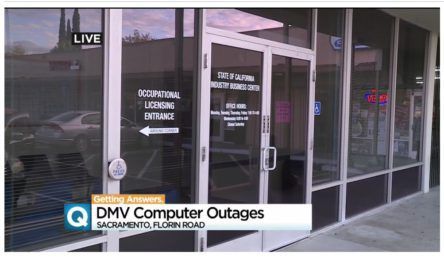DMV ‘meltdown’ latest in long list of CA computer woes
 The government of the state that is home to Silicon Valley and is widely considered the global leader in innovative technology continues to be plagued by problems with computers.
The government of the state that is home to Silicon Valley and is widely considered the global leader in innovative technology continues to be plagued by problems with computers.
On Friday, the California Department of Motor Vehicles reported things were close to normal after a chaotic week of mass computer failures, with just three DMV offices still offline. At one point earlier in the week, more than 120 of the the DMV’s 188 offices statewide were unable to handle such basic tasks as processing requests for new licenses or vehicle registrations.
Both the DMV’s main computer and its primary backup computer suffered what officials called “meltdowns.” In post mortems on the problem, experts outside state government expressed disbelief that both the main and backup computer were directly connected and housed in the same room, making both susceptible to the same risks from overheating, hacking and other problems.
“If their definition of disaster recovery is having primary and backup systems in the same hardware chassis, that’s grotesque,” one expert told The Los Angeles Times.
IT problems with veterans, CalPERS, UC and more
But to followers of the state government, the DMV’s information technology headaches were only the latest in a long line of embarrassing, basic problems.
In June, a report from the state auditor’s office said the California Department of Veterans Affairs had wasted $28 million on an erratic computer system that was supposed to process services and pay bills for care provided to state veterans.
In 2015, the Sacramento Bee reported that attempts to upgrade the state’s payroll and court system computers had been shut down with nothing to show for $850 million in spending. Similar attempts to upgrade payroll computers of the University of California’s campuses and hospitals were reported to be $50 million over budget and two years behind schedule.
In 2013, unemployment benefits for 150,000 residents went unpaid over the Labor Day weekend because of problems with new computers used by the state’s Employment Development Department.
In 2012, the California Public Employees’ Retirement system was besieged by complaints from state retirees whose health insurance policies weren’t being renewed because of problems with CalPERS’ new $514 million computer system.
In 2009, state Controller John Chiang said he was unable to comply with Gov. Arnold Schwarzenegger’s order to furlough state workers and reduce their pay during a budget crisis because the state’s computers were based on a programming language from the 1950s — COBOL — and couldn’t readily be reprogrammed.
Chiang faced charges from Republicans that he was just trying to insulate government union workers from the pain of the budget crisis. But John Thomas Flynn, hired by Gov. Pete Wilson as the state’s first chief information officer, said in a 2009 interview with me that he was inclined to believe Chiang.
Candid self-assessment is not the norm
Flynn has described California government’s computer failures as being the direct result of a culture in which no one is punished when bad things happen and candid self-assessment is rate.
Sacramento-based computer consultant Alex Castro offered a similar observation last year to Bee State Worker columnist Jon Ortiz. He said when an organizational cultures refuse to acknowledge their shortcomings, “they run into brick walls: bad leadership, bad tech people, lack of vision, overestimation of (in-house) skill sets.”
Chris Reed
Chris Reed is a regular contributor to Cal Watchdog. Reed is an editorial writer for U-T San Diego. Before joining the U-T in July 2005, he was the opinion-page columns editor and wrote the featured weekly Unspin column for The Orange County Register. Reed was on the national board of the Association of Opinion Page Editors from 2003-2005. From 2000 to 2005, Reed made more than 100 appearances as a featured news analyst on Los Angeles-area National Public Radio affiliate KPCC-FM. From 1990 to 1998, Reed was an editor, metro columnist and film critic at the Inland Valley Daily Bulletin in Ontario. Reed has a political science degree from the University of Hawaii (Hilo campus), where he edited the student newspaper, the Vulcan News, his senior year. He is on Twitter: @chrisreed99.
Related Articles
Brown gets bipartisan rebuke on drought policies
The reporters who cover state government have paid plenty of attention to Gov. Jerry Brown’s failures on big initiatives in
Ballot initiatives results vary
Katy Grimes: From City of Sacramento races, to the state of Ohio Governor’s race, election predictions appear to be coming
Debate: Brown defends realignment as ‘success’
Questioner asks Kashkari about his key role in the Troubled Asset Relief Program under Presidents Bush and Obama. He strongly



